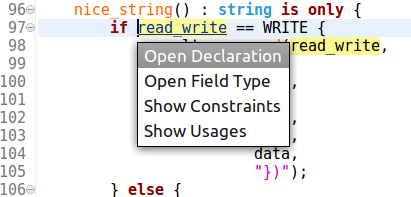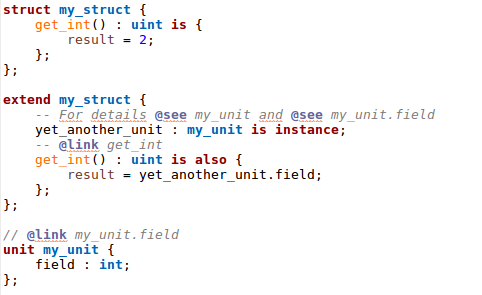Hyperlinks
Place the mouse cursor over an identifier in the editor while holding down the Ctrl key. The identifier becomes a hyperlink, and a list of navigation options is displayed.
The first option is Open Declaration. This is the default action when you click directly on the identifier.
Hyperlinks are available for all the types, methods, fields, macros, etc. from the source code files that DVT analyzes in your project.
Open Declaration |
Tip: Keyboard alternative: place editor cursor on an identifier and press F3. 

|
Open First Implementation |
Opens the first is layer of a method declared using is undefined / is empty. Similarly for events, opens the first layer if definition does not include implementation. 

|
Open … Type |


|
Open When Subtype |
Opens the first explicit implementation of the layer under cursor: 

|
Open Determinant |

Opens the determinant field declaration: 
|
Jump to Binding |
Opens bound method port: 

|
Jump to an Imported File |


|
Jump to a Macro Definition |


|
Hyperlinks in Comments
You can define hyperlinks in comments using the @link or @see pragmas, for example:
-- @link usb_init.usb_init_arch.TIME_SUSPEND
-- For more details @see @see usb_commands::sv_usb_byte and @see usb_fs_monitor.usb_Dn
Hover the hierarchical id specified after the pragma with the mouse cursor while holding down the Ctrl key, and click to go to the element’s declaration.
Alternatively, place the editor cursor on the hierarchical id and press F3

The hierarchical identifier following @link or @see is of the form:
[<package_name>::<type_name>.<inner_type_name>.]<element_name>
where <element_name> must be a type (entity, architecture, etc.) or a type member (method, signal, port etc.).
Examples
@link <element_name>

@link <type_name>.<element_name>

@link <package_name>::<element_name> :

Note
If <path.to.element> does not solve to a unique element in code, a list of navigation options is displayed.
